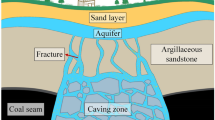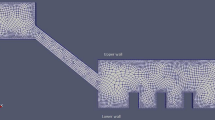Abstract
Wind-driven rain (WDR) is responsible for many potential negative effects on bridges, such as structural cracking, aggregate erosion, steel corrosion and storm water management problems and so on. Hence, accurate evaluations of the WDR effects on bridges are essential to provide solutions for preventing material degradation and improving durability capability of bridges. However, in most previous WDR numerical studies, the turbulent dispersion of raindrops was neglected. In this paper, the turbulent dispersion is integrated into Eulerian multiphase model to investigate the WDR effects on a bridge with rectangular cross-section. Especially, the influences of the turbulent dispersion are discussed in detail by comparing the WDR simulation results for the cases with and without consideration of the turbulent dispersion in terms of WDR flow fields, volume fraction, specific catch ratio, catch ratio, rain loads and aerostatic force coefficients. The results indicate that the turbulent dispersion for a certain range of raindrop size is needed to be taken into account for obtaining accurate WDR simulation results for bridges.














Similar content being viewed by others
References
Tang W, Davidson CI (2004) Erosion of limestone building surfaces caused by wind-driven rain: 2. Numerical modeling. Atmos Environ 38:5601–5609
Tang W, Davidson CI, Finger S, Vance K (2004) Erosion of limestone building surfaces caused by wind-driven rain: 1. Field measurements. Atmos Environ 38:5589–5599
Erkal A, D’Ayala D, Sequeira L (2012) Assessment of wind-driven rain impact, related surface erosion and surface strength reduction of historic building materials. Build Environ 57:336–348
Bosdogianni A, Oliver D (1996) Wind and rain induced oscillations of cables of stayed bridges. J Wind Eng Ind Aerodyn 64:171–185
Masaru M, Tohru S, Masahiko K, Hiromichi S, Takayuki N (1995) Response characteristics of rain-wind induced vibration of stay-cables of cable-stayed bridges. J Wind Eng Ind Aerodyn 57:323–333
Olivier F (1995) Rain-wind induced vibration of cables. J Wind Eng Ind Aerodyn 57:353–362
Matsumoto M, Shiraishi N, Shirato H (1992) Rain-wind induced vibration of cables of cable-stayed bridges. J Wind Eng Ind Aerodyn 43:2011–2022
Hikami Y, Shiraishi N (1988) Rain-wind-induced vibrations of cables in cable stayed bridges. J Wind Eng Ind Aerodyn 29:409–418
Blocken B, Carmeliet J (2004) A review of wind-driven rain research in building science. J Wind Eng Ind Aerodyn 92:1079–1130
Briggen PM, Blocken B, Schellen HL (2009) Wind-driven rain on the facade of a monumental tower: numerical simulation, full-scale validation and sensitivity analysis. Build Environ 44:1675–1690
Blocken B, Carmeliet J (2012) A simplified numerical model for rainwater runoff on building facades: possibilities and limitations. Build Environ 53:59–73
Blocken B, Derome D, Carmeliet J (2013) Rainwater runoff from building facades: a review. Build Environ 60:339–361
Kubilay A, Derome D, Blocken B, Carmeliet J (2013) CFD simulation and validation of wind-driven rain on a building facade with an Eulerian multiphase model. Build Environ 61:69–81
Piaia JCZ, Cheriaf M, Rocha JC, Mustelier NL (2013) Measurements of water penetration and leakage in masonry wall: experimental results and numerical simulation. Build Environ 61:18–26
Blocken B, Abuku M, Nore K, Briggen PM, Schellen HL, Thue JV et al (2011) Intercomparison of wind-driven rain deposition models based on two case studies with full-scale measurements. J Wind Eng Ind Aerodyn 99:448–459
van Hooff T, Blocken B, van Harten M (2011) 3D CFD simulations of wind flow and wind-driven rain shelter in sports stadia: influence of stadium geometry. Build Environ 46:22–37
Blocken B, Carmeliet J (2010) Overview of three state-of-the-art wind-driven rain assessment models and comparison based on model theory. Build Environ 45:691–703
Huang SH, Li QS (2010) Numerical simulations of wind-driven rain on building envelopes based on Eulerian multiphase model. J Wind Eng Ind Aerodyn 98:843–857
Abuku M, Blocken B, Roels S (2009) Moisture response of building facades to wind-driven rain: field measurements compared with numerical simulations. J Wind Eng Ind Aerodyn 97:197–207
Janssen H, Blocken B, Roels S, Carmeliet J (2007) Wind-driven rain as a boundary condition for HAM simulations: analysis of simplified modelling approaches. Build Environ 42:1555–1567
Li HC, Hsieh LS, Chen LC, Lin LY, Li WS (2013) Disaster investigation and analysis of Typhoon Morakot. J Chin Inst Eng 37:558–569
Blocken B, Carmeliet J (2007) On the errors associated with the use of hourly data in wind-driven rain calculations on building facades. Atmos Environ 41:2335–2343
Blocken B, Carmeliet J (2005) High-resolution wind-driven rain measurements on a low-rise building—experimental data for model development and model validation. J Wind Eng Ind Aerodyn 93:905–928
Nascimento MLM, Bauer E, de Souza JS, Zanoni VAG (2016) Wind-driven rain incidence parameters obtained by hygrothermal simulation. J Build Pathol Rehabil 1:1–7
Pettersson K, Krajnovic S, Kalagasidis AS, Johansson P (2016) Simulating wind-driven rain on building facades using Eulerian multiphase with rain phase turbulence model. Build Environ 106:1–9
Kubilay A, Derome D, Blocken B, Carmeliet J (2015) Wind-driven rain on two parallel wide buildings: field measurements and CFD simulations. J Wind Eng Ind Aerodyn 146:11–28
Kubilay A, Derome D, Blocken B, Carmeliet J (2014) Numerical modeling of turbulent dispersion for wind-driven rain on building facades. Environ Fluid Mech 15:109–133
Huang SH, Li QS (2012) Large eddy simulations of wind-driven rain on tall building facades. J Struct Eng 138:967–983
Abuku M, Blocken B, Nore K, Thue JV, Carmeliet J, Roels S (2009) On the validity of numerical wind-driven rain simulation on a rectangular low-rise building under various oblique winds. Build Environ 44:621–632
Blocken B, Dezsö G, van Beeck J, Carmeliet J (2009) The mutual influence of two buildings on their wind-driven rain exposure and comments on the obstruction factor. J Wind Eng Ind Aerodyn 97:180–196
Blocken B, Carmeliet J (2007) Validation of CFD simulations of wind-driven rain on a low-rise building facade. Build Environ 42:2530–2548
Kubilay A, Derome D, Carmeliet J (2017) Analysis of time-resolved wind-driven rain on an array of low-rise cubic buildings using large eddy simulation and an Eulerian multiphase model. Build Environ 114:68–81
Wang H, Hou X, Deng Y (2015) Numerical simulations of wind-driven rain on building facades under various oblique winds based on Eulerian multiphase model. J Wind Eng Ind Aerodyn 142:82–92
Kubilay A, Derome D, Blocken B, Carmeliet J (2014) High-resolution field measurements of wind-driven rain on an array of low-rise cubic buildings. Build Environ 78:1–13
Kubilay A, Derome D, Blocken B, Carmeliet J (2014) Numerical simulations of wind-driven rain on an array of low-rise cubic buildings and validation by field measurements. Build Environ 81:283–295
Lakehal D, Mestayer PG, Edson JB, Anquetin S, Sini J-F (1995) Eulero–Lagrangian simulation of raindrop trajectories and impacts within the urban canopy. Atmos Environ 29:3501–3517
Hangan H (1999) Wind-driven rain studies. A C-FD-E approach. J Wind Eng Ind Aerodyn 81:323–331
Etyemezian V, Davidson CI, Zufall M, Dai W, Finger S, Striegel M (2000) Impingement of rain drops on a tall building. Atmos Environ 34:2399–2412
Lingyun W, Xu YL (2003) Wind–rain-induced vibration of cable: an analytical model (1). Int J Solids Struct 40:1265–1280
ANSYS Inc. ANSYS fluent 14.5 – Theory guide.USA: Canonsburg, Pennsylvania 2011
Zhou LX (2002) Dynamics of multiphase turbulent reacting fluid flows. National Defense Industry Press, Beijing
Hinze JO. Turbulence. McGraw hill 1975
Shirolkar JS, Coimbra CFM, McQuay MQ (1996) Fundamental aspects of modeling turbulent particle dispersion in dilute flows. Prog Energy Combust Sci 22:363–399
De Wolf DA (2001) On the Laws–Parsons distribution of raindrop sizes. Radio Sci 36:639–642
Laws JO, Parsons DA (1943) The relationship of raindrop size to intensity. Trans Am Geophys Union 24:452–460
Gunn R, Kinzer GD (1949) The terminal velocity of fall for water droplets in stagnant air. J Meteorol 6:243–248
Atlas D, Srivastava RC, Sekhon RS (1973) Doppler radar characteristics of precipitation at vertical incidence. Rev Geophys 11:1–35
Gousseau P, Blocken B, van Heijst GJF (2013) Quality assessment of Large-Eddy Simulation of wind flow around a high-rise building: validation and solution verification. Comput Fluids 79:120–133
Fransos D, Bruno L (2010) Edge degree-of-sharpness and free-stream turbulence scale effects on the aerodynamics of a bridge deck. J Wind Eng Ind Aerodyn 98:661–671
Simiu E, Scanlan RH (1996) Wind effects on structures, 3rd edn. Wiley, New York
Wind-resistant Design Specification for Highway Bridges. JTG/T D60-01-2004, China
Abuku M, Janssen H, Poesen J, Roels S (2009) Impact, absorption and evaporation of raindrops on building facades. Build Environ 44:113–124
Buljac A, Kozmar H, Pospíšil S, Macháček M (2017) Aerodynamic and aeroelastic characteristics of typical bridge decks equipped with wind barriers at the windward bridge-deck edge. Eng Struct 137:310–322
Xu FY, Li BB, Cai CS, Zhang Z (2014) Experimental investigations on aerostatic characteristics of bridge decks under various conditions. J Bridge Eng 19:1–12
Gu M, Zhang R, Xiang H (2000) Identification of flutter derivatives of bridge decks. J Wind Eng Ind Aerodyn 84:151–162
Tominaga Y, Mochida A, Murakami S, Sawaki S (2008) Comparison of various revised k–ε models and LES applied to flow around a high-rise building model with 1:1:2 shape placed within the surface boundary layer. J Wind Eng Ind Aerodyn 96:389–411
Acknowledgements
The work described in this paper was fully supported by a grant from Environmental Conservation Fund (ECF) of Hong Kong (Project No: 9211097 (19/2015)), a grant from National Natural Science Foundation of China (Project No: 51478405) and a grant from 111 Project of China (Project No: B18062). The authors would like to thank the editor and reviewers for their valuable comments for the improvement of this paper.
Author information
Authors and Affiliations
Corresponding author
Rights and permissions
About this article
Cite this article
Liu, M., Huang, S.H., Yan, B.W. et al. Modelling of turbulent dispersion for numerical simulation of wind-driven rain on bridges. Environ Fluid Mech 18, 1463–1489 (2018). https://doi.org/10.1007/s10652-018-9603-y
Received:
Accepted:
Published:
Issue Date:
DOI: https://doi.org/10.1007/s10652-018-9603-y




